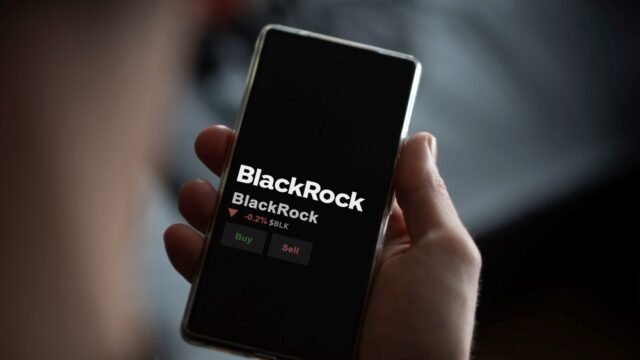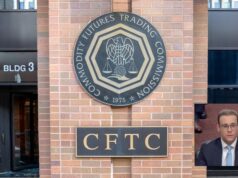As the cryptocurrency derivatives market rapidly expands, BlackRock is positioning its tokenized money-market fund, BUIDL, as a game-changing asset in the world of collateral. With discussions underway between BlackRock and leading crypto exchanges such as Binance, OKX, and Deribit, the question on everyone’s mind is whether BUIDL will become the go-to collateral for institutional traders, who have traditionally relied on stablecoins like Tether (USDT) for this purpose.
BUIDL by BlackRock: A New Kind of Collateral
Launched in March 2024, BlackRock’s BUIDL token is a digital representation of the firm’s USD Institutional Digital Liquidity Fund. The stable-value fund invests primarily in US Treasury bills, cash, and repurchase agreements. Its value is pegged at $1 per token, similar to stablecoins like USDT. However, it differs significantly in its structure and target audience.
Unlike stablecoins, which are widely used by retail and institutional traders alike, BUIDL is designed specifically for institutional investors. It requires a minimum investment of $5 million. The token is part of BlackRock’s broader strategy to merge the stability of traditional finance with the speed and efficiency of blockchain technology.
The Competitive Landscape: BUIDL vs. Stablecoins
Stablecoins, especially USDT, have long dominated the crypto derivatives market as preferred collateral due to their liquidity, market familiarity, and ease of use. In September 2024, over 70% of the total crypto trading volume was attributed to derivatives contracts. Many of those contracts relied on stablecoins for collateral.
BlackRock, however, sees an opportunity to challenge this dominance. BUIDL’s backing by highly liquid, traditional assets like Treasury bills gives it a unique position as a secure and reliable form of collateral. BlackRock’s reputation as a trusted asset manager could make BUIDL particularly appealing to institutional traders, prioritizing transparency and regulatory compliance.
Crypto brokers such as FalconX and Hidden Road already use the token as collateral. Its potential adoption by major exchanges like Binance, OKX, and Deribit could further cement its place in the derivatives ecosystem.
The Institutional Push: Why BlackRock Could Succeed with BUIDL
One of BUIDL’s key strengths is its association with BlackRock, a firm with over $11 trillion in assets under management. Institutional investors often favor products from established and trusted financial institutions, giving BUIDL a significant advantage over its stablecoin competitors.
Additionally, BlackRock’s digital assets strategy aims to bridge the gap between traditional finance and the crypto world. BUIDL’s backing by tangible, low-risk assets makes it an attractive proposition for institutional players who may be wary of the volatility that often characterizes the crypto space. Moreover, BlackRock’s strategic partnerships with blockchain firms like Securitize enhance the token’s credibility.
The Road Ahead: Challenges and Adoption
Despite its strong potential, the widespread adoption of BUIDL as collateral is far from guaranteed. Stablecoins like USDT and USDC have a first-mover advantage in the crypto derivatives space. Their liquidity and familiarity make them hard to displace. Moreover, the user base for stablecoins extends far beyond institutional players, giving them a broader appeal.
Another challenge is whether crypto exchanges and traders will be willing to integrate BUIDL into their systems. While exchanges like Binance and OKX are reportedly in discussions with BlackRock, the actual implementation will require significant coordination and technological adjustments. Additionally, the crypto derivatives market is highly competitive, and convincing traders to switch from well-established collateral options could take time.
>>> Read more: BlackRock Bets On Ethereum For Asset Tokenization
Conclusion: A Long-Term Play
BlackRock’s push to have BUIDL accepted as collateral represents a significant development in the tokenization of traditional assets. If successful, it could signal a shift in how institutional traders approach collateral in the crypto derivatives market, offering a more secure and compliant option backed by real-world assets. However, the dominance of stablecoins and the inertia of existing systems pose considerable challenges to BUIDL’s widespread adoption.
In the coming months, as discussions with exchanges progress and the crypto market continues to evolve, it will become clearer whether BUIDL can live up to its potential. For now, BlackRock’s initiative represents a bold move in the intersection of traditional and digital finance – one that could pave the way for greater institutional involvement in the crypto space. Whether BUIDL will ultimately become the collateral of choice for institutional traders remains to be seen.
Readers’ frequently asked questions
How does BUIDL differ from traditional stablecoins like Tether (USDT)?
While both BUIDL and Tether (USDT) serve as stable-value tokens, their fundamental differences lie in their underlying structure and target audience. BUIDL is a tokenized money market fund. It is primarily backed by traditional, liquid assets such as US Treasury bills, cash, and repurchase agreements. This gives BUIDL a strong connection to traditional financial assets, making it a more secure and potentially less volatile option, especially for institutional investors prioritizing transparency and regulatory compliance.
On the other hand, Tether backs its USDT stablecoin with a combination of cash, cash equivalents, and other assets. They may not always be as transparent or tied to traditional financial instruments. Retail and institutional investors use USDT more widely due to its liquidity, and it is already an established form of collateral across most crypto exchanges. BUIDL, by contrast, has a higher minimum investment threshold, making it primarily suited for institutional players. That limits its accessibility compared to USDT. This difference means BUIDL is targeted at a more niche, institutional market, whereas USDT serves a broader audience across both retail and institutional sectors.
What advantages does BlackRock BUIDL offer over other collateral options in the crypto market?
BUIDL offers several unique advantages, particularly for institutional investors who seek security and reliability. First, its backing by highly liquid assets like US Treasuries makes BUIDL an inherently stable and secure token. This backing reduces the risk of volatility that can sometimes affect other collateral options in the crypto space, even stablecoins. BlackRock’s reputation as the world’s largest asset manager adds to BUIDL’s credibility. It could make institutional traders more comfortable using it over other, less transparent collateral forms.
Furthermore, BUIDL’s integration into major exchanges like Binance and OKX, should the discussions be successful, could open new avenues for large-scale institutional participation in the crypto derivatives market. Its tokenization on the Ethereum blockchain offers efficiency and transparency. Being part of BlackRock’s larger digital asset strategy reinforces its legitimacy. However, the main advantage is the trust and stability derived from its traditional financial backing. It gives it a distinct edge over other crypto-native tokens, particularly in uncertain or volatile market conditions.
What challenges does BlackRock face in promoting BUIDL as collateral for crypto derivatives?
While BUIDL has significant potential, BlackRock faces several challenges in getting it widely adopted as collateral. One of the biggest hurdles is convincing exchanges and traders, who already widely accepted and use stablecoins like USDT and USDC across the industry, to adopt a new collateral system. Having a first-mover advantage and being deeply embedded into the existing trading infrastructure of most crypto derivatives platforms, makes it difficult for any new entrant, even one backed by BlackRock, to displace these stablecoins.
Moreover, technical integration with exchanges such as Binance, OKX, and Deribit is no small feat. It requires collaboration between multiple stakeholders, which could delay the adoption of BUIDL. There’s also the question of whether institutional traders will see enough value in switching to BUIDL. After all, they are already familiar with stablecoins that have similar benefits. Lastly, regulatory concerns and evolving crypto market regulations could affect the speed and scale at which BUIDL is accepted. These factors suggest that while BUIDL’s future is promising, BlackRock will need to address these obstacles to secure widespread adoption in the crypto derivatives space.
What Is In It For You? Action Items You Might Want to Consider
Monitor BUIDL’s Adoption by Major Exchanges
As BlackRock continues talks with exchanges like Binance, OKX, and Deribit, keep a close eye on announcements or platform updates that confirm the adoption of BUIDL as collateral. Early adoption of BUIDL by these exchanges could create new opportunities for derivatives trading, especially if BUIDL gains traction as a stable and secure alternative to traditional stablecoins. Being proactive in identifying when and where BUIDL becomes available could give you an edge in adjusting your trading strategies.
Evaluate BUIDL’s Suitability as Collateral for Your Portfolio
If you’re an institutional trader or have access to higher capital reserves, consider whether BUIDL’s backing by US Treasuries and cash aligns with your risk tolerance and trading needs. Given its stability and the backing of BlackRock, BUIDL might be a better fit for conservative strategies or during times of heightened market volatility. Assess whether using BUIDL could help you reduce risk compared to traditional stablecoins, which might be subject to more market fluctuations.
Stay Updated on Regulatory Developments
The regulatory landscape for digital assets is continually evolving. Upcoming rules or regulatory approvals may influence BlackRock’s initiative with BUIDL. For example, the potential changes in how tokenized assets like BUIDL can be used as collateral could have significant implications for its adoption. Keep track of decisions from regulatory bodies, especially the Commodity Futures Trading Commission (CFTC), to anticipate how regulations could impact the availability and legal framework surrounding BUIDL in the derivatives market. Staying informed will help you navigate both opportunities and risks as they emerge.










